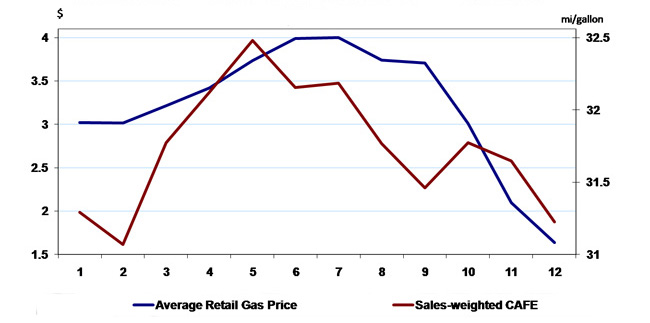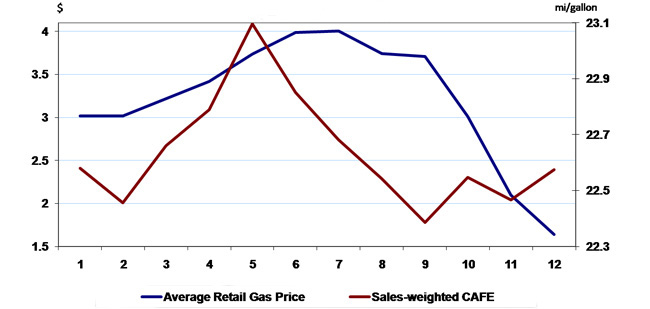Fuel efficiency challenges in the auto industry
A recent symposium at our Detroit Branch addressed the automotive industry’s challenges in meeting stricter fuel efficiency standards. The 2007 energy bill set a new target of 35 miles per gallon for the corporate average fuel efficiency (CAFE) of new vehicle sales . The new fuel efficiency requirements will be phased in beginning with model year (MY) 2011. Such standards are motivated by concerns for the global environment (e.g., global warming), as well as national security (since gasoline and petroleum are imported from volatile regions of the world). Yet, efforts to meet the stricter standards will impose higher costs on all automakers selling in the U.S., including the domestic ones, which are already strained.
Recently the Obama administration moved up the year by which the new requirements have to be met from MY2020 to MY2016. The National Highway and Traffic Safety Administration (NHTSA) is charged with issuing and monitoring compliance with fuel efficiency standards. The Obama administration also instructed the U.S. Environmental Protection Agency (EPA) to regulate for the first time greenhouse gas (GHG) emissions by automobiles. Although separate rules will apply as determined by CAFE and GHG standards, the two government agencies intend to harmonize and coordinate their efforts.
New rules regarding the fuel efficiency standards will be administered based on each individual vehicle’s “footprint,” meaning the area of the vehicle as one looks down from above. Per the new standards, each class of vehicle, as measured by its footprint, must meet a certain level of fuel efficiency by 2016. There was consensus at our workshop that the new standards can be met with existing technology. Yet, there was wide disagreement on how costly compliance will be. In any case, the cost of complying with the new requirements is expected to be higher for larger vehicles.
Tighter requirements for fuel efficiency could be quite onerous for vehicle manufacturers—especially were the price of gasoline to stay low. That is because consumers will continue to demand large cars and powerful (fuel-burning) engines. In contrast, during last summer’s episode of high prices for gasoline, consumers responded by switching to more fuel-efficient vehicles (see below).
1. 2008 monthly gas price vs. sales-weighted CAFE (cars)

2. 2008 monthly gas price vs. sales-weighted CAFE (light trucks)

As gasoline prices have fallen since then, there’s a shift once again toward larger and more powerful vehicles. With regard to future fuel prices, few believe that the current administration and U.S. Congress intend to raise the road-use tax on gasoline. However, the price of gasoline could go up if a carbon emissions “cap-and-trade” program were implemented. Such programs have been and are currently being considered in both the House of Representatives and the Senate. A Congressional Research Service study estimates that at a price of $15 per ton of carbon, the price of gasoline would rise by 14 cents based on its carbon content.
In order to meet the new fuel economy and greenhouse targets, automakers will be looking to use technologies available at the lowest cost per fuel economy improvement. There was agreement at the meeting that most likely we will see further improvements to the internal combustion engine as well as increased use of more advanced transmissions, such as six-speed automated transmissions and dual clutch transmissions. Reduction of a vehicle’s weight and engine size (a smaller engine in combination with turbocharging can provide similar power to that of larger engines) are also in the mix. Finally, there are several advanced engine management options, such as cylinder deactivation, variable valve timing, and gasoline direct injection. These technologies would improve fuel economy between 3% and 7% each, at a cost of up to $300 each. In addition, increased use of biofuels can represent significant benefits to carmakers in terms of achieving CAFE compliance. It is also widely expected that automakers will apply improvements to a vehicle’s air conditioning system to achieve reductions in GHG emissions.
The application of diesel-burning engine technology—popular and proven to be quite successful in Europe—will be more challenging in the U.S. because of stricter regulations related to the control of smog (which is associated with some noncarbon emissions). Finally, possible next generation technologies such as hybrid powertrains as well as fuel cells, while intriguing, were widely characterized as being not yet cost competitive.
The Federal government will assist domestic auto producers in improving energy performance. Today Energy Secretary Steven Chu announced the first tranche of funding awarded to support improvements in energy efficiency in the motor vehicle sector. The advanced technology vehicles manufacturing program, appropriated in fall of 2008, will provide $25 billion dollars in loans to companies making cars and components in U.S. factories that increase fuel economy at least 25 percent above 2005 levels.








